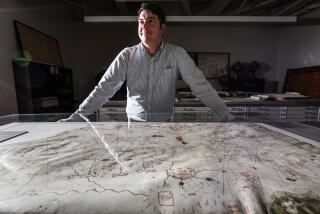Finding his place in the world
The World of Gerard Mercator
The Mapmaker Who Revolutionized Geography
Andrew Taylor
Walker & Co.: 292 pp., $26
*
Gerard Mercator’s 16th century breakthrough in mapmaking was a tragedy for the Western imagination. Of course it led to better ocean navigation and fewer sailors’ widows. But his creation of an accurate map of the world shoved aside all those exotic lands and fantastic sea serpents that filled maps -- and people’s dreams -- before he came along.
The earliest chapters of Andrew Taylor’s “The World of Gerard Mercator” describe the bits of fact and fancy that explorers brought back from the edges of the known world -- delightful stories of mythic kings, cannibals and surreal landscapes too mushy to walk or sail upon.
Written in the tradition of biography-histories such as Simon Winchester’s “The Professor and the Madman” and Dava Sobel’s “Galileo’s Daughter,” Taylor’s book skillfully reconstructs Mercator’s life and times, reminding us that he lived in an era of superstition and fierce religious conflict. Someone seeking scientific knowledge could easily draw the ire of the Inquisition, which had a reach extending to northern Europe. In fact Mercator was jailed, but Taylor says scant information exists about exactly why this mild-mannered Flemish scholar was imprisoned or how benefactors were able to secure his release. One suspects that he would have died in prison if he hadn’t been a successful cartographer. The tremendous desire to open trade routes to the Far East created powerful guardians for men like Mercator, who helped explorers move confidently into unknown territory.
“Columbus, Vasco da Gama and scores of other daring mariners ... pushed back the shadows and found new lands for their countrymen to conquer,” Taylor writes, “Gerard Mercator, hunched over his desk in Duisburg, redrew the world and hung it on the wall.”
Though his imagination roved the world as he relocated continents and discarded centuries-old lore, Mercator hardly ventured outside Antwerp, Leuven and other nearby towns. Born 20 years after Columbus’ first Atlantic voyage, he learned engraving and cartography from masters such as Gemma Frisius and won the patronage of Charles V, the Holy Roman Emperor. When the last vestiges of the bubonic plague pandemic killed several members of Mercator’s family, he combated his grief by working on the “Cosmographia,” a massive (unfinished) ancestor to our modern encyclopedia that he thought would secure his fame.
Instead, true fame was secured by what is now known as the Mercator projection -- a method of mapping a sphere on a flat surface, still used today (Mariner 9, in fact, used it to map parts of Mars in the early 1970s), that resulted in more trustworthy images of the world than people had seen before.
“What had not been established by exploration was supplied by imagination or faith,” Taylor writes of the mapmakers preceding Mercator. “[T]he maps that the medieval Christian scholars drew were
Before Mercator, the salons of aristocrats glittered with gorgeous painted globes like that by Martin Behaim -- he called his an erdapfel (“earth-apple”) -- and spectacular world maps known as mappaemundi that merged biblical details with real places and landmarks.
So beautiful, and so useless.
A navigator using one of these was guaranteed to get lost. Sailors routinely missed their destinations by hundreds of miles because their maps didn’t take into account the curve of the Earth’s surface. A flat map straightened out the lines of longitude and made them parallel (on a globe, these lines narrow and meet at both poles), forcing sailors to say a prayer as they constantly adjusted course.
But Mercator realized the distortion could be minimized by proportionally adjusting the lines of latitude. Mercator left no notes for his innovation, and Taylor’s description of the method will give some who didn’t major in math a headache, but the result was that sailors were given “the ability to follow a straight course across the map.”
The map that resulted, Mercator’s 1569 map of the world, is about 7 feet tall and shows just how far cartography had come from the mappaemundi. Here one sees a world very close to the one we know today. Often Taylor resorts to words such as “perhaps” or “most likely” in describing how Mercator felt or reacted -- so few records of his personal life exist that the author is forced to speculate. But this doesn’t diminish the book: It forces Taylor at times to leave his subject behind and instead paint a rich picture of the times. One reads this book marveling at the efforts to wrest fact from fiction that confronted scientists such as Mercator on a daily basis.
*
Nick Owchar is acting deputy editor of Book Review.
More to Read
Sign up for our Book Club newsletter
Get the latest news, events and more from the Los Angeles Times Book Club, and help us get L.A. reading and talking.
You may occasionally receive promotional content from the Los Angeles Times.






